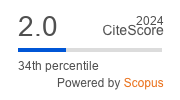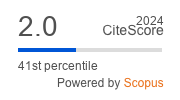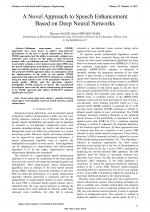| 2/2022 - 9 |
A Novel Approach to Speech Enhancement Based on Deep Neural NetworksSALEHI, M. |
| Extra paper information in |
| Click to see author's profile in |
| Download PDF |
Author keywords
long short-term memory, machine learning, mean square error methods, recurrent neural networks, speech enhancement
References keywords
speech(31), processing(15), access(14), enhancement(13), learning(11), signal(9), noise(9), estimation(8), deep(8), spectral(7)
Blue keywords are present in both the references section and the paper title.
About this article
Date of Publication: 2022-05-31
Volume 22, Issue 2, Year 2022, On page(s): 71 - 78
ISSN: 1582-7445, e-ISSN: 1844-7600
Digital Object Identifier: 10.4316/AECE.2022.02009
Web of Science Accession Number: 000810486800009
SCOPUS ID: 85131727505
Abstract
Minimum mean-square error (MMSE) approaches have been shown to achieve state-of-the-art performance on the task of speech enhancement. However, MMSE approaches lack the ability to accurately estimate non-stationary noise sources. In this paper, a long short-term memory fully convolutional network (LSTM-FCN) is utilized to accurately estimate a priori signal-to-noise ratio (SNR) since the speech enhancement performance of an MMSE approach improves with the accuracy of the used a priori SNR estimator. The proposed MMSE approach makes no assumptions about the characteristics of the noise or the speech. MMSE approaches that utilize the LSTM-FCN estimator are evaluated using the mean opinion score of the perceptual evaluation of speech quality (PESQ) and the short-time objective intelligibility (STOI) measures of speech. The experimental investigation shows that the speech enhancement performance of an MMSE approach that utilizes LSTM-FCN estimator significantly increases. |
| References | | | Cited By |
Web of Science® Times Cited: 1 [View]
View record in Web of Science® [View]
View Related Records® [View]
Updated today
SCOPUS® Times Cited: 3
View record in SCOPUS® [Free preview]
View citations in SCOPUS® [Free preview]
[1] Steel Surface Defect Detection Method Based on Improved YOLOv9 Network, Zou, Jialin, Wang, Hongcheng, IEEE Access, ISSN 2169-3536, Issue , 2024.
Digital Object Identifier: 10.1109/ACCESS.2024.3453931 [CrossRef]
[2] Deep learning for speech denoising with improved Wiener approach, Abdelli, Ouardia, Merazka, Fatiha, International Journal of Speech Technology, ISSN 1381-2416, Issue 4, Volume 27, 2024.
Digital Object Identifier: 10.1007/s10772-024-10148-y [CrossRef]
Disclaimer: All information displayed above was retrieved by using remote connections to respective databases. For the best user experience, we update all data by using background processes, and use caches in order to reduce the load on the servers we retrieve the information from. As we have no control on the availability of the database servers and sometimes the Internet connectivity may be affected, we do not guarantee the information is correct or complete. For the most accurate data, please always consult the database sites directly. Some external links require authentication or an institutional subscription.
Web of Science® is a registered trademark of Clarivate Analytics, Scopus® is a registered trademark of Elsevier B.V., other product names, company names, brand names, trademarks and logos are the property of their respective owners.
Faculty of Electrical Engineering and Computer Science
Stefan cel Mare University of Suceava, Romania
All rights reserved: Advances in Electrical and Computer Engineering is a registered trademark of the Stefan cel Mare University of Suceava. No part of this publication may be reproduced, stored in a retrieval system, photocopied, recorded or archived, without the written permission from the Editor. When authors submit their papers for publication, they agree that the copyright for their article be transferred to the Faculty of Electrical Engineering and Computer Science, Stefan cel Mare University of Suceava, Romania, if and only if the articles are accepted for publication. The copyright covers the exclusive rights to reproduce and distribute the article, including reprints and translations.
Permission for other use: The copyright owner's consent does not extend to copying for general distribution, for promotion, for creating new works, or for resale. Specific written permission must be obtained from the Editor for such copying. Direct linking to files hosted on this website is strictly prohibited.
Disclaimer: Whilst every effort is made by the publishers and editorial board to see that no inaccurate or misleading data, opinions or statements appear in this journal, they wish to make it clear that all information and opinions formulated in the articles, as well as linguistic accuracy, are the sole responsibility of the author.



